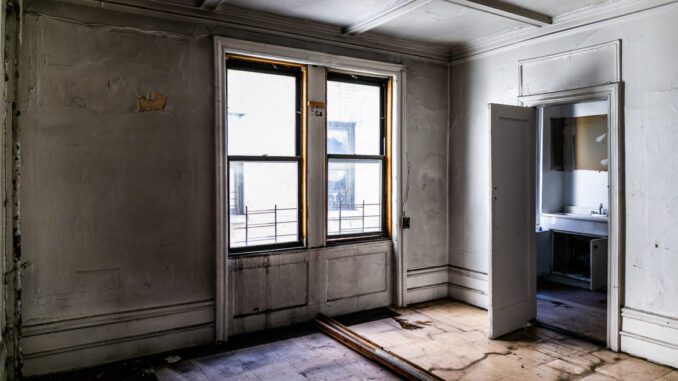
Estimated reading time: 7 minutes
According to the New York City Housing Preservation and Development Department, there are at least 88,000 vacant, rent-stabilized apartments in New York City. Even while more than 100,000 New Yorkers experience homelessness and many more struggle to pay ever-increasing rent, landlords purposefully keep these apartments vacant and do not advertise their existence in order to create demand for the non-stabilized apartments they own — the apartments where they can charge more money.
Rent stabilization is a legal status created by the city government under which landlords can only increase the rent by a certain percentage every year. They may not evict a tenant unless the tenant has violated the lease, and they must sign one or two-year leases with the tenant (as opposed to the landlord’s favorite type of lease, the oral month-to-month, where they can evict or eject tenants for no reason at all at the drop of a hat). New York’s rent stabilization guidelines were created in 1969 as “market-friendly” alternatives to the more stringent controls on rent increases during and immediately following World War 2. These policies had been seen as necessary to keep workers — whose labor was needed in the city’s manufacturing industry — from being displaced by soaring rents. However, by the 1970s, advances in shipping and computation technology allowed capitalists to increasingly export labor costs to the Third World. Hard-fought union struggles increased the wages and working standards of industrial workers in the U.S. Meanwhile, capitalists hired death squads to terrorize laborers in the Third World, and stymy socialist and union organizing. They then took advantage of the non-existence of strong union contracts in the Third World to pay these workers far less than their U.S. counterparts. This left urban working-class communities who had relied on these jobs to support themselves, particularly Black communities, who were also systematically denied mortgages for suburban homes, with no prospects for decent wages.
As New York City deindustrialized, the city government cut the social services of these neighborhoods with the explicit goal of displacing the residents — what they dubbed “planned shrinkage.” The impacts were immediate and devastating. Just under 1 million people were displaced or killed by the sudden loss of social services. When it was no longer profitable to the capitalists for workers to live in the city, the state began to erode rent stabilization, including the elimination of rent stabilization for any building constructed after 1974. Real estate speculators took advantage of the many buildings in disrepair and in escrow and bought them for pennies on the dollar. Landlords invested in the reconstruction of these buildings because, once reconstructed, they were no longer subject to rent stabilization. They “reconstructed” them for the explicit purpose of evading rent stabilization requirements!
By the 1990s, corporations began to open offices in New York City, bringing their administrative workers with them. Neighborhoods that were depopulated under “planned shrinkage” were filled by office and service workers. This influx of people provided renewed ways for landlords to profit. The New York State government, in order to facilitate their profiteering, continued the attack on rent stabilization. In 1994, it legislated that any unit whose rent was more than $2,000 per month could be destabilized. Landlords began a frenzy of alteration and tweaking to their units in order to justify a $2,000 rent. Once the properties were destabilized, these same landlords left them to decay once more while they collected inflated rents.
Rent stabilization was never designed to end homelessness or housing insecurity. It was an attempt by the city to manage the contradiction between rapidly rising rents that force the poor to leave the city and the need for a working-class to fill jobs in the city, while protecting the class of people who profit from rent collection and exploitation of labor — the landlords and capitalists.
Rather than force the landlords to rent out these stabilized units, New York City Mayor Eric Adams gave landlords $10 million to renovate stabilized units and list them at market prices. The city government revealed its true nature by protecting and facilitating the profitability of speculative enterprises. The mayor of New York City gave free money to the landlords, not free housing to the people.
According to data gathered by the city of New York, about half of non-owner-occupied New York City apartments are rent-stabilized. This allows many families and individuals to continue to reside in neighborhoods they grew up in, and prevents rent costs from eating their entire paycheck. Rent stabilization is an undeniable good; we can and should defend it. Still, we shouldn’t delude ourselves into thinking its protection or expansion will make housing really fair or equitable, let alone that it can bring about an equitable world. As long as the landlord class controls the production and distribution of housing, they use housing as a means to enrich themselves while bleeding the working class of the crumbs we receive as wages. One of the chief functions of the U.S. government is to manage the crises caused by this kind of speculation. However, contrary to the commonly held misconception that the government does this to help the people, their role is to ensure the bankers and landlords who gamble with the people’s money can get bailouts, handouts, and a leg up.
It is our responsibility to end this domination and bring about a society in which goods and services are produced according to ability and distributed according to need, not hoarded for the luxury of a few. We who seek to end this domination must form study groups with our friends, coworkers, and loved ones to collectively understand how this system of domination works. From these study groups, we can organize tenants to collectively struggle against our landlords for better living conditions.
We must organize defense units, and prevent the protection racket known as the NYPD from evicting our neighbors out of their homes and displacing our homeless neighbors from their camps. It’s through these organizations that we, the working class, can exercise our power. As we do, we will take on not just the immediate effects of the housing crisis (the necessary survival programs for the houseless, eviction-defense squads, etc.) but the very institutions of government that permit the landlords to flourish and, ultimately, the landlords themselves. It’s not just New York City, as practically any working-class person can attest. Housing is either unaffordable or unattainable across the entire United States and Canada. Wherever we may be, we must embed ourselves in and establish organizations like these and put an end to the rule of parasitic landlords and bosses!

